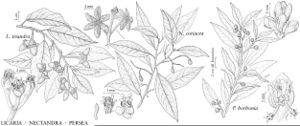Nectandra
Acta Lit. Univ. Hafn. 1: 279. 1778, name conserved.
| Taxon | Illustrator ⠉ | |
|---|---|---|
 | Nectandra coriacea Persea borbonia Licaria triandra | John Myers John Myers John Myers |
Trees or shrubs, evergreen. Bark dark reddish-brown [brown, or gray], smooth with small wartlike lenticels. Leaves alternate. Leaf-blade pinnately veined, papery or leathery; surfaces variously pubescent; domatia absent. Inflorescences appearing when mature leaves present, axillary, panicles, usually many-flowered. Flowers bisexual, 5-17 mm diam.; tepals deciduous, white or greenish, equal, spreading at anthesis, with papillose hairs on adaxial surface; stamens 9, anthers 4-locular, anthers of outer 6 stamens introrse, locules arranged in arc, anthers of inner 3 stamens extrorse; staminodes 3, very small, sometimes absent. Drupe dark blue or black, ± elongate, seated in shallow [or cupshaped], single-rimmed cupule.
Distribution
Nearly all neotropical
Discussion
Species ca. 120 (1 in the flora).
Selected References
None.